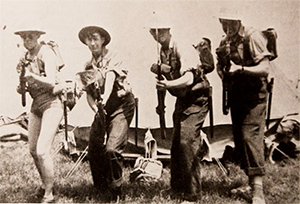How dancing on campus helped conserve gasoline during Second World War

The temporary buildings of the post-war years, including the 'Rec Hut', second from left, in 1946.
It was 1941 and Bernard Trotter had just arrived on campus at McMaster University.
Big band leader Glenn Miller’s hit song “Chattanooga Choo Choo” had been released only months before, and the Lindy Hop was spreading across the continent – but not at McMaster.
Believe it or not, dancing was banned at the University by an order included in founder Senator William McMaster’s will.
The ban meant students were forced to organize dances off campus – and that meant burning up valuable gasoline in the drive out to “the country.”

In an effort to conserve gas, which was rationed during the war, Chancellor George Gilmour used the wartime emergency to lift the ban, allowing students to dance on campus for the first time.
The anecdote, related by Humanities alumnus Trotter on the eve of the 70th anniversary of Victory in Europe Day, is one of dozens of snapshots of campus life posted to the #McMasterMemory project.
“I remember, in particular, getting to one event at a converted barn in the country in the rumble seat of a friend’s car,” writes Trotter. “This was high living indeed…”
The lifting of the dance ban wasn’t the only change in campus business necessitated by the war.
As it did in the Great War, McMaster authorized a volunteer contingent of the Canadian Officers’ Training Corps, made up of two companies of 150 men (out of a student population of approximately 600).
The University also built a Drill Hall in the area now occupied by the GO transit terminal.
The Hall, opened in the fall of 1943, served as a base for the COTC regiment and as a place for the formals, dances and balls now allowed on campus.


